Primavera 2022: Young Australian Artists
Nick Croggon
As you enter Primavera 2022, you may catch a work by the Wiradjuri poet and artist, Jazz Money. It’s a short sound piece that emanates from a speaker lodged in the ceiling near the entrance to the gallery. In it, Money recites a short poem that addresses the site of the exhibition, the meeting place of two bodies of water: Warang, the saltwater bay on whose shore the Museum of Contemporary Art stands, and the Tank Stream, the freshwater tributary that runs in a concrete pipe beneath the museum’s floors. It’s a typically spare and beautiful piece.
However, you might just as easily miss it. Money’s recital of the poem is bookended by a long phrase of silence, meaning that many visitors walk (as I did on my first visit) into the show without stopping. If you know it’s there (because you notice the wall label), you’ll need to linger in the doorway, awkwardly, not quite inside or outside the exhibition and unsure when or if the piece will play.
This gesture is an elegant framing device for the exhibition, functioning something like an Acknowledgement of Country. Yet if the form of the institutional Acknowledgement can sometimes feel formulaic or empty, Money’s version fills it with life. It orients the visitor to both a state of attentiveness to the moment at hand, and an uncertainty as to what may emerge from it.
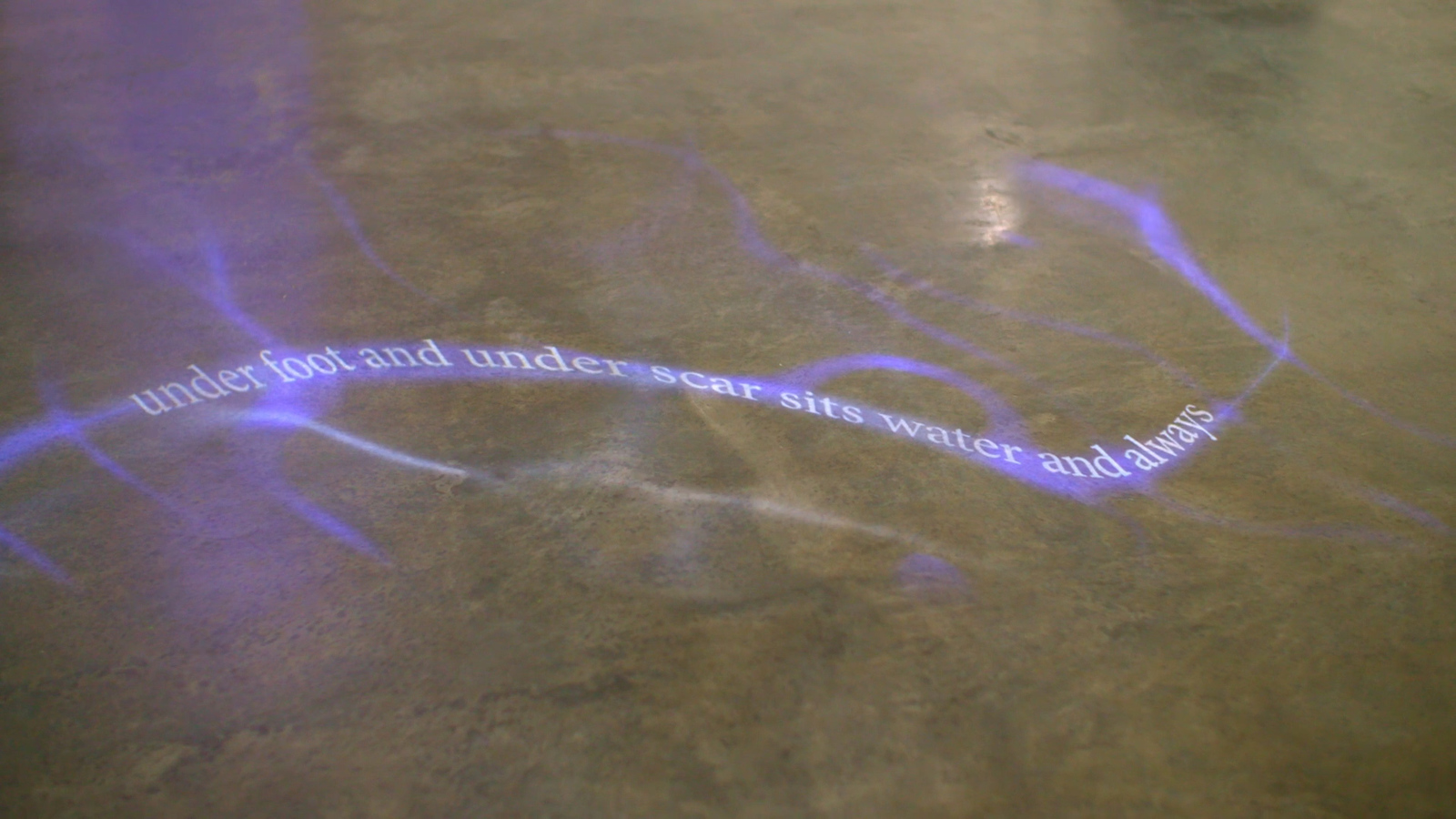
The Museum’s annual Primavera exhibition is explicitly concerned with emergence. Each year a curator is invited to produce a survey of “young Australian artists”, defined as artists below the age of thirty-five. Established in 1992, it is one of the oldest of the many Australian exhibitions focused on the new and emerging in art, such as Hatched at Perth’s Institute of Contemporary Art, Blaze at the Canberra Contemporary Art Space and the Macfarlane Commission at ACCA (and its precursor, NEW).
This year’s Primavera is curated by Michael Do, who is currently based at the Sydney Opera House. Although in the past the exhibition has included as many as thirteen artists, Do continues the more recent trend of a more constrained show, showcasing just six artists: Money, Sundari Carmody, Julia Gutman, Angela Goh, Amrita Hepi and Katie West.
The exhibition’s introductory wall text, which you encounter immediately as you enter the gallery, offers a refrain familiar from survey exhibitions of recent years. We live, it states, in a time of suffering and loss: environmental emergency, far-right politics, global pandemic and colonialism. In his curator’s essay, Do describes this moment in even more grandly morbid terms as a “global requiem”. It’s a morose start.
There is no denying, of course, that the Australian arts sector is living in the aftermath of crisis. Over the past few years, the combined effects of fire, flood and plague have taken an immeasurable toll on the physical and mental health of artists and their audiences, and on the ability of artists to earn a living. A recent House of Representatives Standing Committee report confirmed that the pandemic had impacted employment in the creative and performing arts at a disproportionately high rate compared to other industries. At the same time, the government measures put in place to address the crisis (such as JobSeeker and JobKeeper) were often not available to artists and their institutions.
As many recognised, this condition was not only a consequence of the pandemic, but of almost ten years of Coalition government, whose dislike for the visual arts manifested in both random attacks (remember George Brandeis’s Australia Council coup?) and a more insidious slow withdrawal of funding. Although throughout the pandemic the government would often express how crucial art had been to sustain us through crisis, it was always also quick to assert that it must always remain somehow outside or beyond politics. As my fellow Memo writer Giles Fielke has pointed out, the pandemic exposed art’s paradoxical status as both essential and non-essential: necessary for any bearable form of life, yet also outside the political and economic realm that the government undertook to sustain.
The new Labour government has offered an alternative paradigm for art. In contrast to the Coalition’s policy of abandonment, the current government is developing a cultural policy (due at the end of this year) that will supposedly return art to the heart of political life. This involves undeniably positive developments: the priority of First Nations cultures, the recognition of the artist as worker and a commitment to diversity and accessibility. Underpinning this policy, however, is a familiar argument: that art is essential because it facilitates economic growth and progress. Under this model, emerging art is valuable because it provides new ideas and technological innovation, making Australia more competitive on the global stage.
The task for an institutional exhibition of emerging art today is to plot a path between these two models of art. Is art simply a panacea for the present, a salve that allows us to tolerate a condition of perpetual crisis? Or is it solely justified by its future economic and intellectual utility?
I found in Do’s Primavera the traces of a third option: an art that emerges, that plays with the rigid forms of the present to create a future characterised by multiplicity and uncertainty.
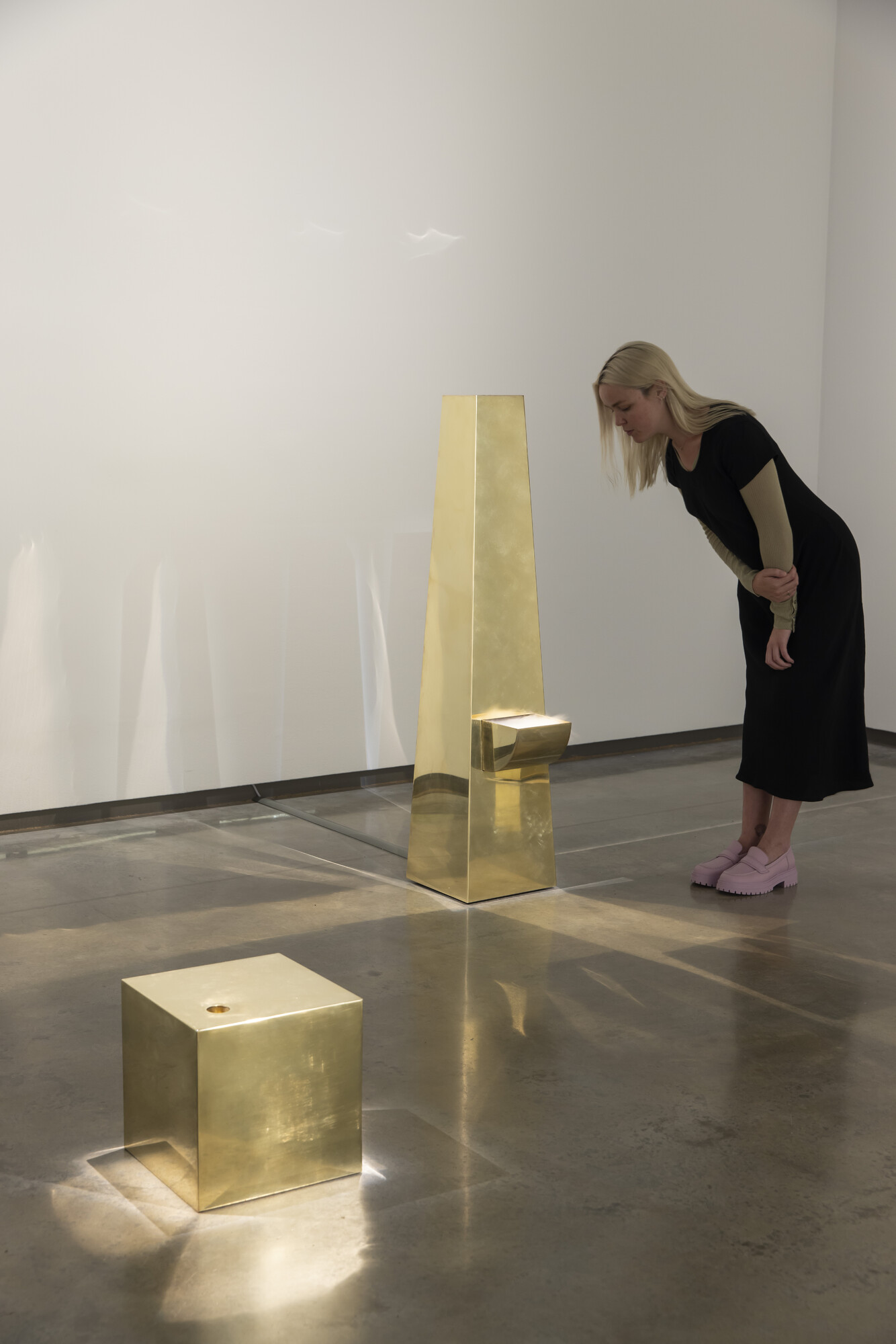
So, to the works themselves.
The logical starting point for the show inside the gallery is The Mountain (2022), an installation of three polished brass sculptures by Sundari Carmody, with each having a distinct elemental emanation—mist, water, or a smell. The primary forms are reminiscent of the minimalist work of James Lee Byars and Walter de Maria, and like these, invite the viewer to explore their objecthood, bending down to smell the (elusive) scent or circling the taller obelisk. Also like Byars, Carmody links this experience of simple shapes to a radical “openness” of meaning, suggesting “cosmic encounters”, “ancient and pre-historic civilisations” and “new-age spiritual practices” (a territory trodden more sceptically by artists like Min Wong).
An answer to this radical freedom of interpretation is provided immediately by the exhibition’s next two works by dancers and choreographers Amrita Hepi and Angela Goh. Hepi’s Open Poses (2022) invites the viewer around the corner into a small room fitted out with a camera, a green screen, and a pair of monitors. The viewer is shown an image from Hepi’s “data-set” of poses, and then invited to try to emulate it in front of the green screen—if successful, the viewer’s image is superimposed on Hepi’s and shown to audiences on a screen outside the room.
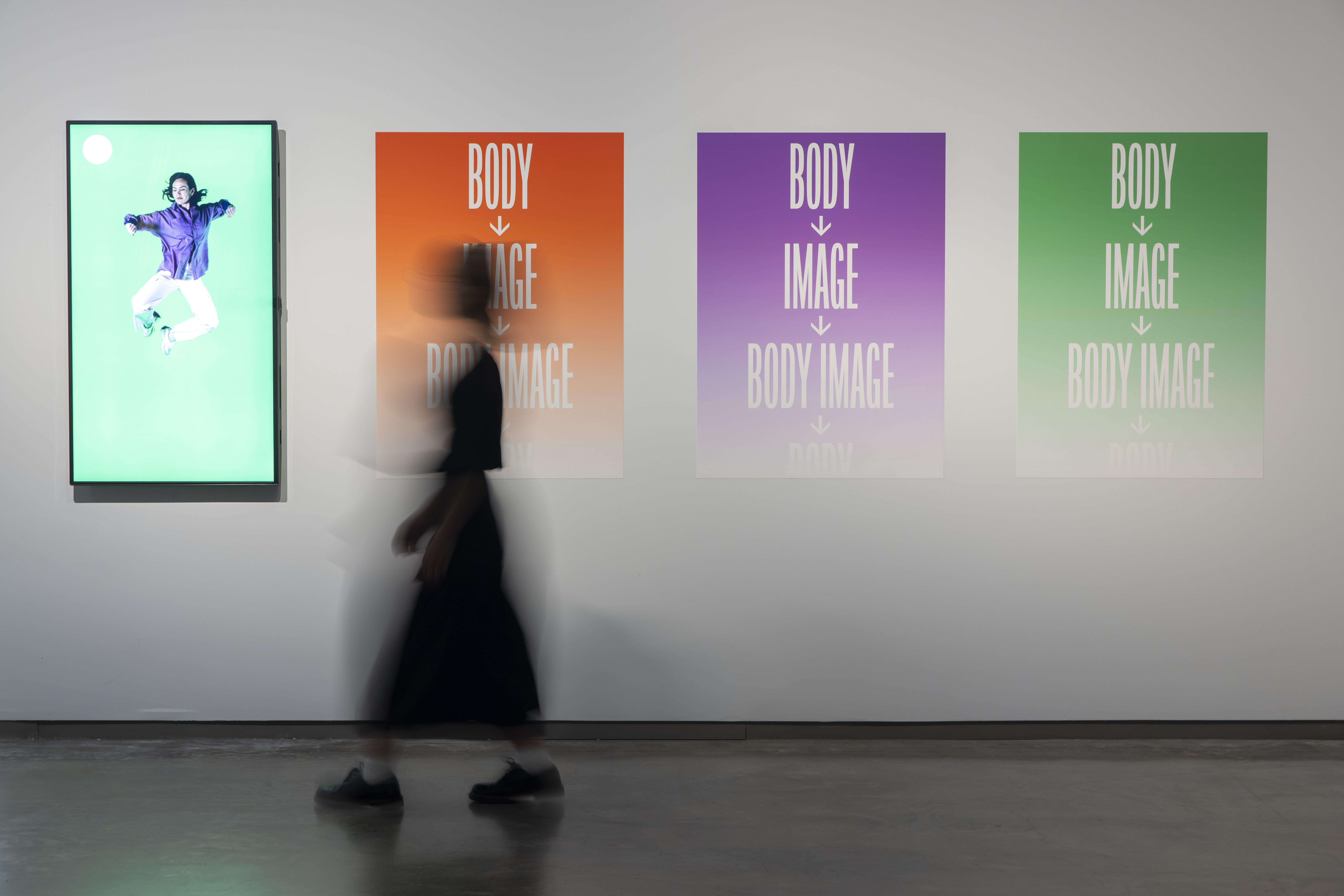
Hepi’s point here is blunt and cynical: the open space of bodily movement that Carmody’s work points to is always already striated by image technologies that record, isolate and classify, a premise pithily summarised by a set of posters on the wall: “BODY—>IMAGE—>BODYIMAGE”. Indeed, the work would seem too cynical, were it not for the fact that the viewer’s gestures and Hepi’s never do quite match up. The viewer’s attempts at replication, and their visual comparison on the screens, only produce messiness, confusion and laughter.
It is this messiness that Goh takes as her starting point. The work, Gloss (2021—) uses as its material a solo dance piece, Blue Sky Mythic, that Goh performed at the Sydney Opera House in 2020. Goh attempts to do what Hepi’s apparatus suggests has actually already taken place: reduce her gestures and movements to a set of distinct forms that allow for replication. This attempt takes three formats: a video recording split across two screens; a set of twenty-eight drawings pinned to the wall, and a spray of photocopied photographs, drawings and words arranged haphazardly on a table.
While Hepi suggests (initially at least) that gesture is always controlled by the image, Goh’s efforts are designed to illustrate that such control is impossible. This much is clear as one tries to find correlations between the video performance and the wall drawings, or make sense of the mass of documents on the table. Goh’s work enacts a deliberate indeterminacy, a transformation of a single work into an infinitely variable set of forms, ideas and possibilities.

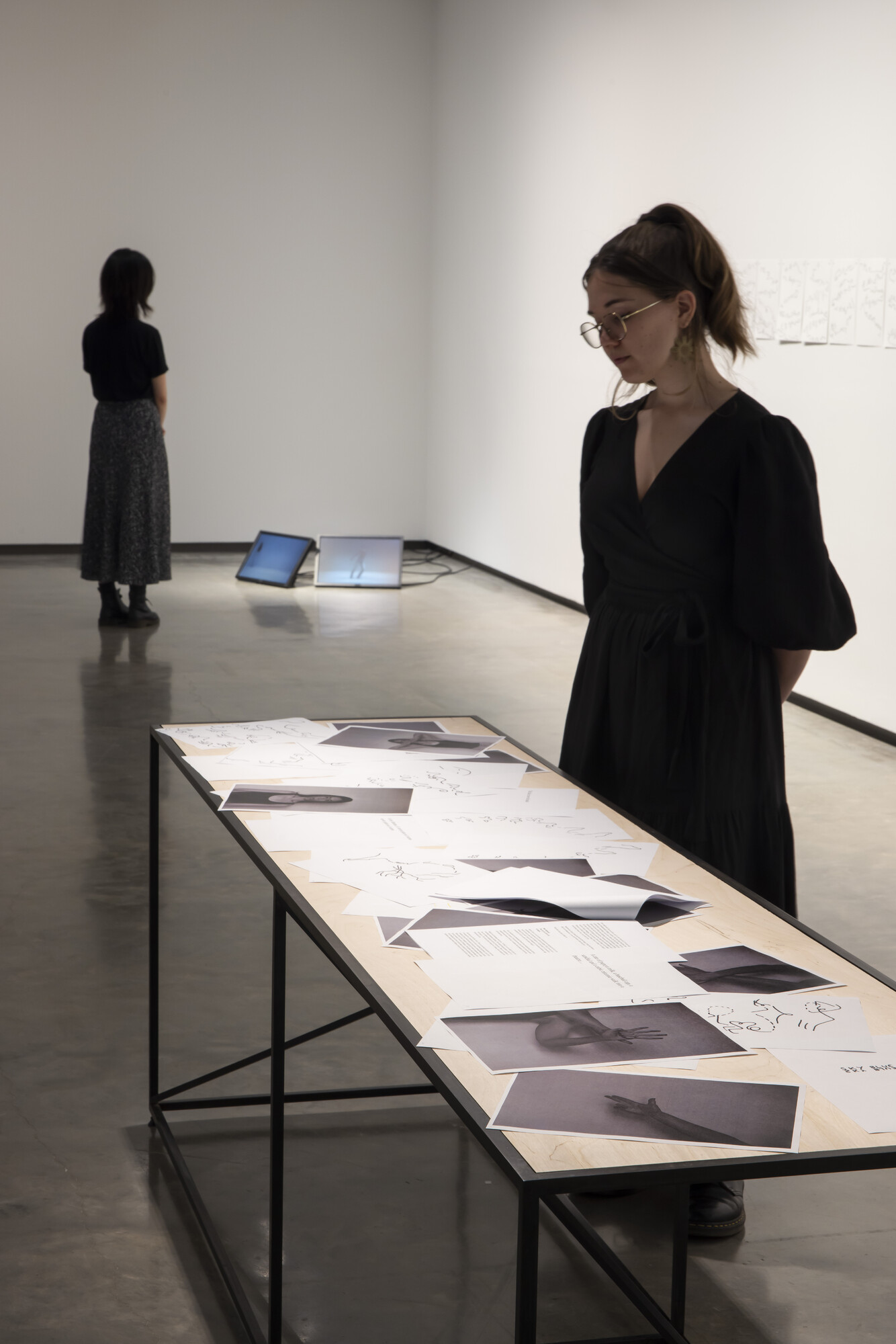
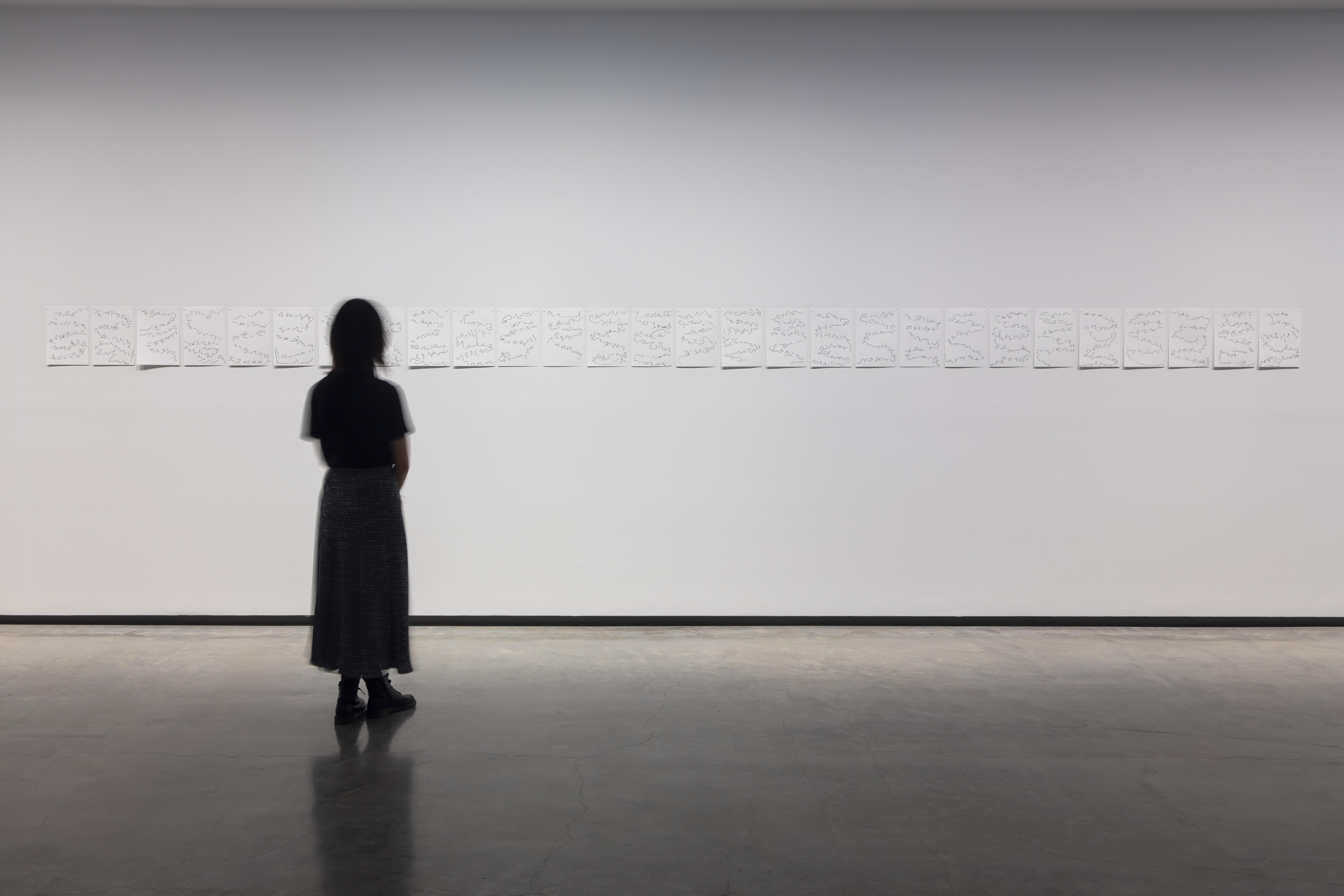
If dance and movement undergirds the exhibition’s first half, it is textile work that seems to link the next half. Sydney-based artist Julia Gutman’s work occupies the space opposite Goh’s, and comprises an embroidered mural of six figures stretched across five conjoined blanket canvases. As the wall text explains, Gutman’s practice is motivated by a politics that addresses textile work’s marginal status as craft and women’s work, and embraces its sustainability and communality (like Paul Yore, Gutman sources her materials from friends and family).
Yet standing in front of the work, this politics (already foregrounded in 2022 exhibitions like In the Fibre of Her Being, which also included Gutman) feels like a distraction from the intricate politics at work in the picture itself. The piece deliberately lifts us up out of the real space of bodies and work, and into the virtual space of representation: it begins with a figure stepping off the gallery floor into the work, and curves around the gallery’s corner to end with a reclining figure who deposits us gently back onto the gallery floor.
As in the work of artists like Helen Johnson or Zoe Marni Robertson, Gutman uses the tactics of history painting—figure, ground, ground—to give gravitas to the everyday: a trio of friends, the stoic gaze of a pregnant woman, someone engrossed in a book. Yet the work does not simply show the figures that history painting traditionally excluded—rather, it pulls such figuration apart at the seams. As one leans in closer to the work, the singular figures unravel into a tangle of messy reworking, loose threads and textural layers.

Katie West is also a textile artist. The core of her work is the natural dyeing process, whereby West collects leaves, flowers and bark to infuse fabric with colour over heat or in the sun. For this work West returned to her ancestral Yindjibarndi Country, where she filmed herself walking along the shoreline collecting driftwood. While previously West’s installations have foregrounded a finished product, here her fabric is transformed into two screens for the projection of a meditation on process itself. The driftwood West collects in the video has been deposited in the gallery seemingly untransformed, instead forming a loose barrier that prevents us approaching the fabric screen. In contrast to Gutman’s communal approach, West’s creative process appears as both introspective (we rarely see her face) and deeply personal, an engagement with her Country and the trauma of separation that is not accessible to the viewer. Instead, the work communicates the therapeutic nature of this process through a doubled rhythm of rippled sand and rippled water, and the steps of two feet, that echoes and bounces between the film’s two screens.
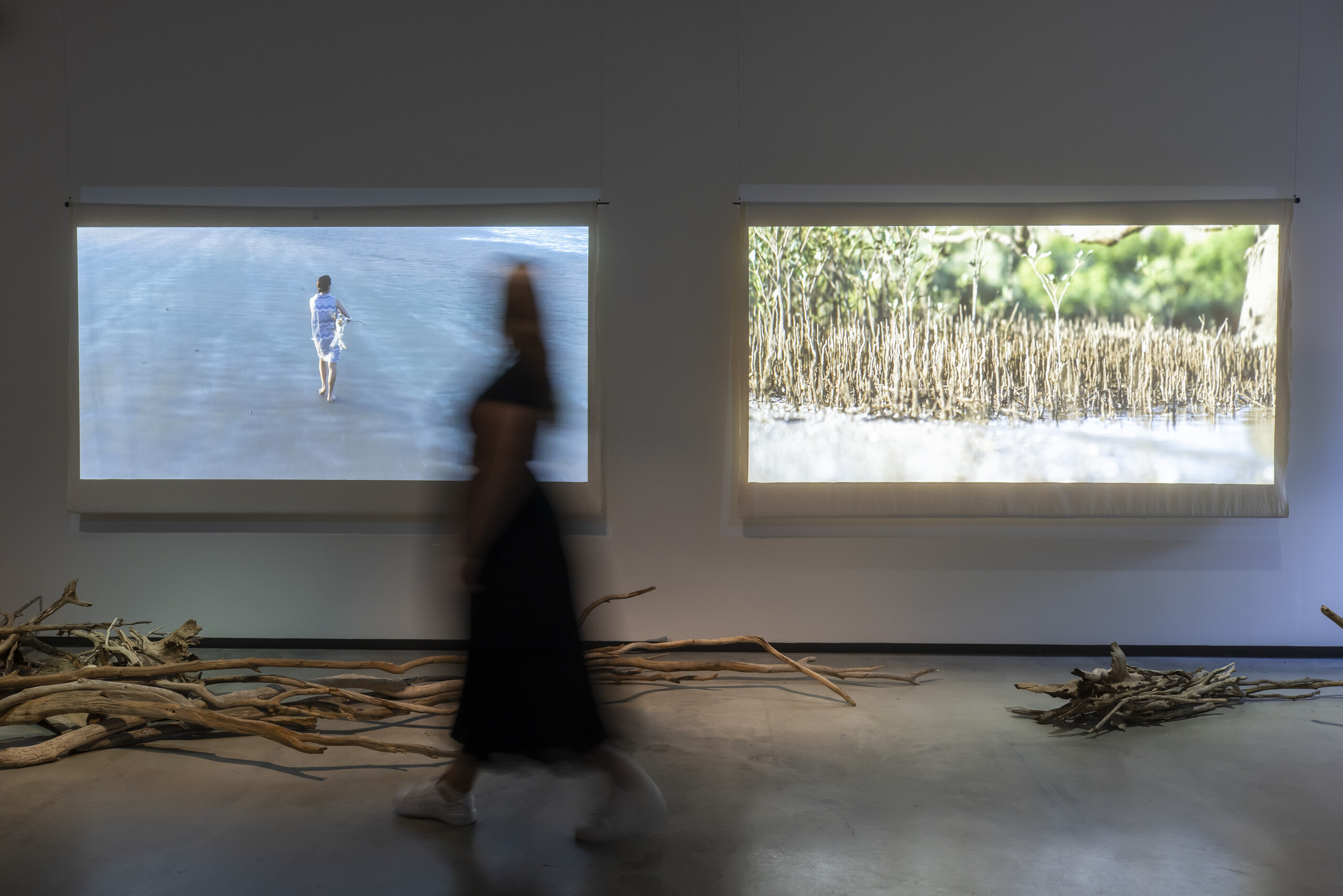
There is a logic of doubling that threads through this exhibition, and it is once again Money’s work, Hold this water in the water of your knowing, that expresses this device most succinctly. In the title of the piece, the water that flows under Tallawoladah (itself already doubled, as a joining of salt- and freshwater) doubles as a figure to evoke both Country (this water) and the faculty of knowledge (the water of knowing). Money frequently points to these kinds of doublings and the flights of thought they produce as central to the unnameable (in English, at least) difference offered by the Wiradjuri language and worldview.
In a similar way, Do’s tightly and elegantly curated Primavera presents the viewer with a sequence of pairings and doublings, present in the works themselves and in the synergies and oppositions between them. These doublings, which only ever produce multiplicity and uncertainty, refuse the easy binaries of old and new, essential or non-essential, before or after Covid. It is an art emerging into an as yet undetermined future.
Nick Croggon is an art historian, writer and editor based on Gadigal and Wangal land. He is Events and Programs Officer at the Power Institute, and is completing a PhD at Columbia University, New York.


